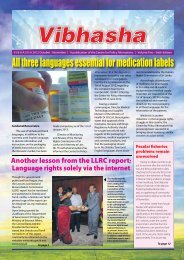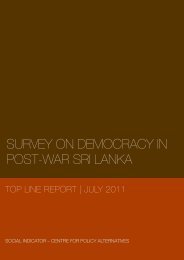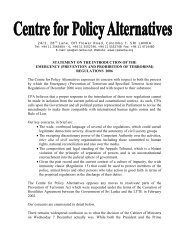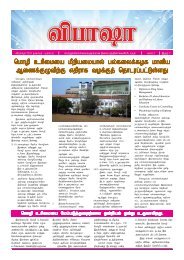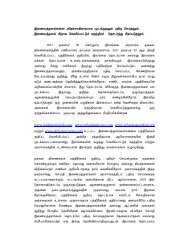States of Emergency - Centre for Policy Alternatives
States of Emergency - Centre for Policy Alternatives
States of Emergency - Centre for Policy Alternatives
Create successful ePaper yourself
Turn your PDF publications into a flip-book with our unique Google optimized e-Paper software.
Supreme Court was initially restrained in the engagement <strong>of</strong> its<br />
fundamental rights jurisdiction under Article 126 <strong>of</strong> the 1978<br />
Constitution, which contemplated a more robust role <strong>for</strong> the court<br />
in the en<strong>for</strong>cement <strong>of</strong> justiciable positive rights against executive<br />
and administrative action.<br />
Thus <strong>for</strong> example in Yasapala v. Wickremasinghe (1980), the<br />
Supreme Court held that the President was the sole arbiter <strong>of</strong> the<br />
circumstances necessitating a Proclamation <strong>of</strong> emergency and was<br />
not bound to state reasons <strong>for</strong> that decision. Sharvananda J. held<br />
that, “It is not competent <strong>for</strong> the Court to examine whether a<br />
Regulation was reasonable in the circumstances or likely to<br />
achieve the object <strong>of</strong> defusing the emergency. It is not the objective <br />
fact but the subjective opinion <strong>of</strong> the President that it is necessary<br />
or expedient to pass a regulation that is a condition <strong>of</strong> the<br />
regulation‐making power.” 315 His Lordship relied on a number <strong>of</strong><br />
Commonwealth cases, but primarily on the opinion <strong>of</strong> Lord Greene<br />
M.R. in Carltona Ltd .v. Commissioners <strong>of</strong> Works (1943) to the effect<br />
that. “All that a Court can do is to see that the power which it is<br />
claimed to exercise is one which falls within the four corners <strong>of</strong><br />
the powers given by the legislature and to see that those powers<br />
are exercised in good faith. Apart from that, the Courts have no<br />
power at all to inquire into the reasonableness, the policy, the<br />
sense or any other aspects <strong>of</strong> the transaction.” 316<br />
However, the Supreme Court soon started developing a more<br />
assertive role. In Edirisuriya v. Navaratnam (1985), the Court<br />
315<br />
Yasapala v. Wickremasinghe (1980) 1 FRD 143 at 155‐156, emphasis added;<br />
Janatha Finance and Investments v. Liyanage (1982) 2 FRD 373<br />
316<br />
Carltona Ltd .v. Commissioners <strong>of</strong> Works (1943) 2 All ER 560 at 564; see also<br />
Bhagat Singh v. King Emperor (1931) AIR 111 (PC); H.W.R. Wade & C.F. Forsyth<br />
(1994) Administrative Law (7 th Ed.) (Ox<strong>for</strong>d: Clarendon Press): p.442 et seq.<br />
195



